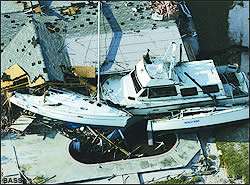
TALLAHASSEE, Fla. — Four months later, resource managers still are assessing damage done to fisheries by the four hurricanes that assaulted Florida this past fall. Early indications are that bass and other fish species fared much better than did the people and property in the Sunshine State, with billions of dollars in damage to homes, buildings, roads and utilities.Thus far, only minor fish kills have been reported, along with scattered damage to habitat and access areas and economic losses to marinas, tackle shops and other fisheries-related businesses.”While long-term damage remains to be evaluated, Florida’s aquatic systems have evolved to quickly recover from these natural storm events,” explained Dale Jones, fisheries management section leader for the Florida Fish and Wildlife Conservation Commission (FWC).
The kills that did occur, he said, were largely the result of low dissolved oxygen. Such conditions were created when heavy rains and runoff stirred up bottom sediments and washed organic matter, including plants and animal wastes, into lakes and rivers.”As the debris decays, the process uses the dissolved oxygen in the water faster than it can be replenished,” explained Sam McKinney, an FWC regional biological administrator.”At the same time, the overcast skies and muddy waters reduce sunlight, so alga does not produce oxygen, and the result is that there is not enough dissolved oxygen in the water for the fish to breathe.”Hurricane-related kills likely will not harm fisheries in the long term, Jones added. “As the effects of storm events diminish, fish rapidly disperse and utilize desirable habitats.”The arrival of winter in Florida is being welcomed by fisheries managers like Jones.”Several of our large systems continue to have low oxygen conditions (less than one part per million),” he said. “But no large fish kills have been documented. Cooler temperatures should help diminish potential for loss of fisheries.”Waters most impacted by the hurricanes include the following:Lake Okeechobee: “Two of the storms dumped nearly 30 inches of rain onto the lake and its watershed, raising water levels to the highest they’ve been since before World War II. Hurricane Jeanne generated 25-foot waves, which dislodged large areas of rooted aquatic vegetation,” Jones said. “Re-suspended bottom sediments produced water colors described as ‘coffee with creamer.’ Elevated water levels inundated littoral areas with the discolored water and radically increased potential for habitat loss.”Lower St. Johns River: “Isolated fish kills occurred here, and dissolved oxygen remains low in some areas. In other places, such as Lake George, oxygen levels are recovering. The upper St. Johns had sparse, isolated kills in the main-stem river, but Stick Marsh, Kenansville and Garcia are alive and well.”Ocklawaha River: Jones said there were “scattered” kills reported in the Ocklawaha as well, and dissolved oxygen remains low in Rodman Reservoir. “Effects of hurricanes have not interrupted plans to draw down Rodman this winter, and dewatering is proceeding on schedule.”Withlacoochee River: This system probably has suffered the most from heavy rains and runoff, with oxygen nearly absent in places. Fish have died here, just as they did following heavy rains in 2002. “This system functions differently than other Florida streams in that the river’s headwaters (the Green Swamp) stores water and releases big pulses of oxygen-poor water that results in fish kills,” Jones said. “The Tsala Apopka Chain and Lake Panosofkee, which are associated with the Withlacoochee River, experienced minor oxygen-related kills.”

